Atomic Physics Quotes & Sayings
Enjoy reading and share 51 famous quotes about Atomic Physics with everyone.
Top Atomic Physics Quotes
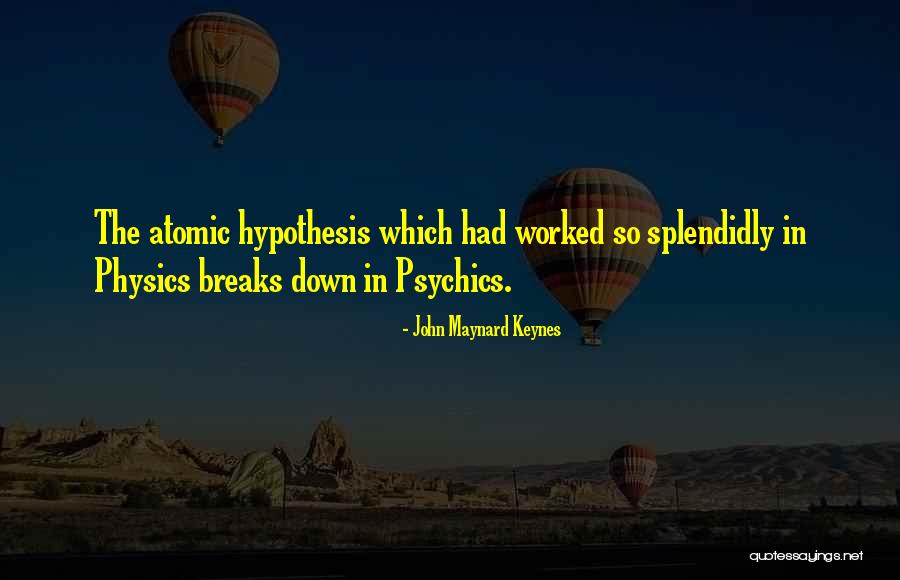
The atomic hypothesis which had worked so splendidly in Physics breaks down in Psychics. — John Maynard Keynes
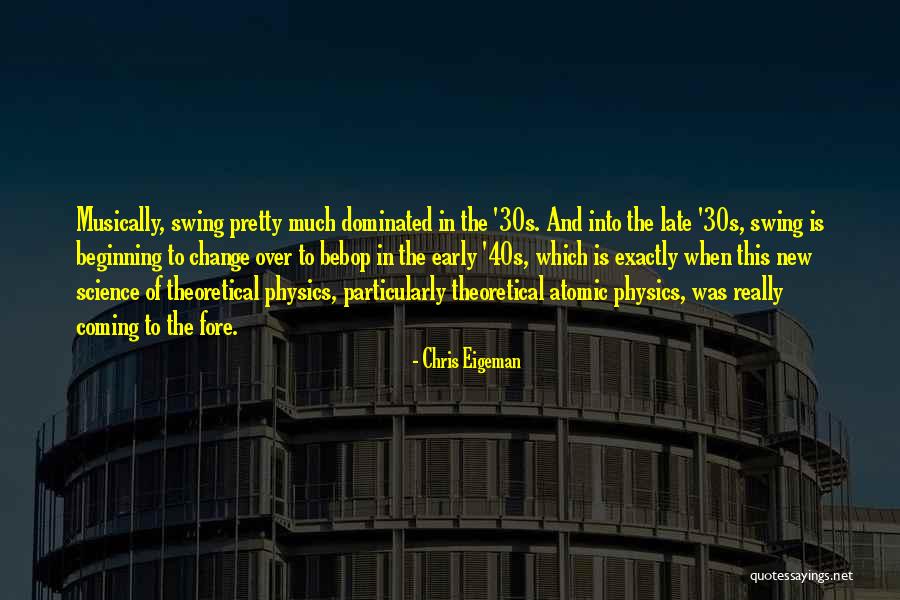
Musically, swing pretty much dominated in the '30s. And into the late '30s, swing is beginning to change over to bebop in the early '40s, which is exactly when this new science of theoretical physics, particularly theoretical atomic physics, was really coming to the fore. — Chris Eigeman
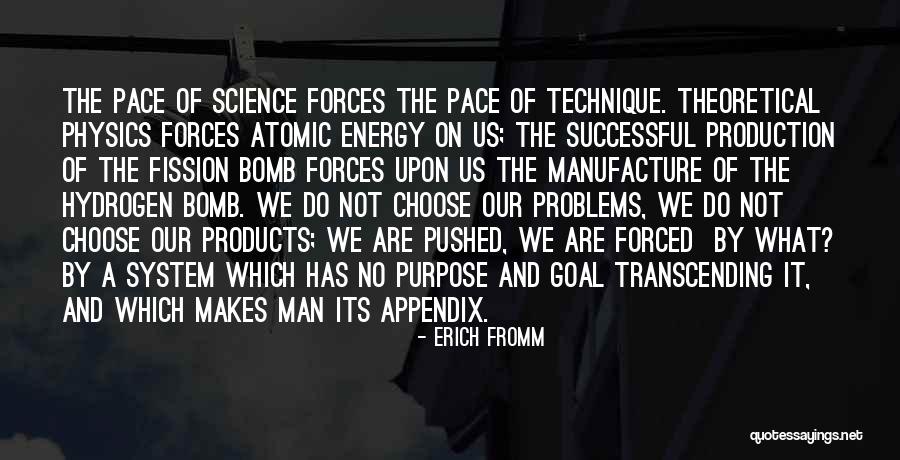
The pace of science forces the pace of technique. Theoretical physics forces atomic energy on us; the successful production of the fission bomb forces upon us the manufacture of the hydrogen bomb. We do not choose our problems, we do not choose our products; we are pushed, we are forced
by what? By a system which has no purpose and goal transcending it, and which makes man its appendix. — Erich Fromm
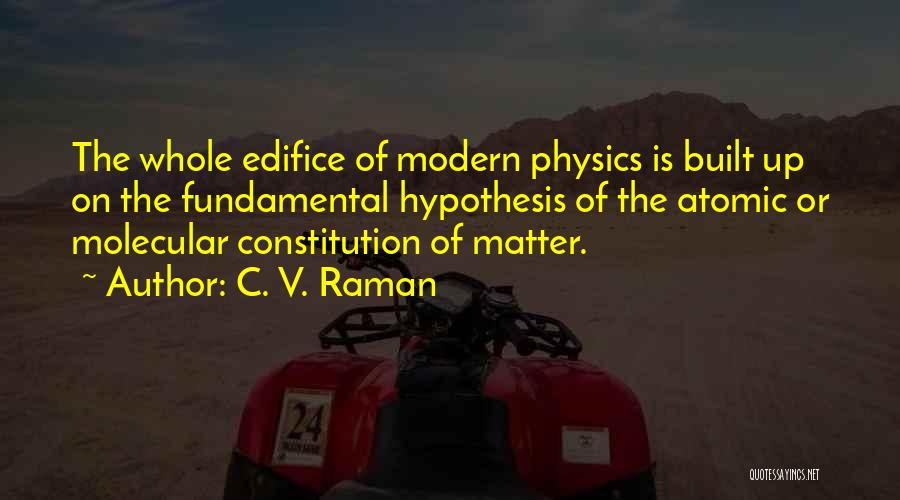
The whole edifice of modern physics is built up on the fundamental hypothesis of the atomic or molecular constitution of matter. — C. V. Raman
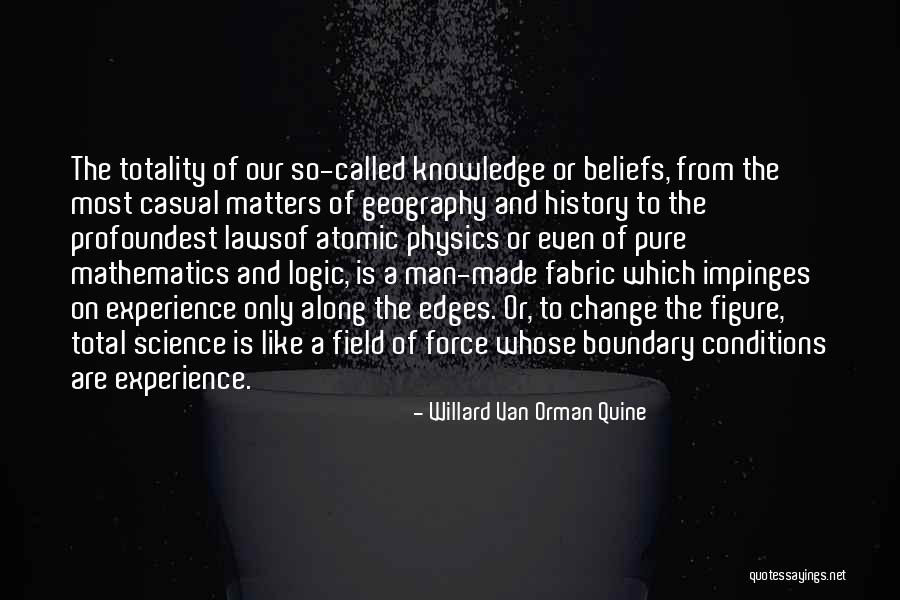
The totality of our so-called knowledge or beliefs, from the most casual matters of geography and history to the profoundest lawsof atomic physics or even of pure mathematics and logic, is a man-made fabric which impinges on experience only along the edges. Or, to change the figure, total science is like a field of force whose boundary conditions are experience. — Willard Van Orman Quine
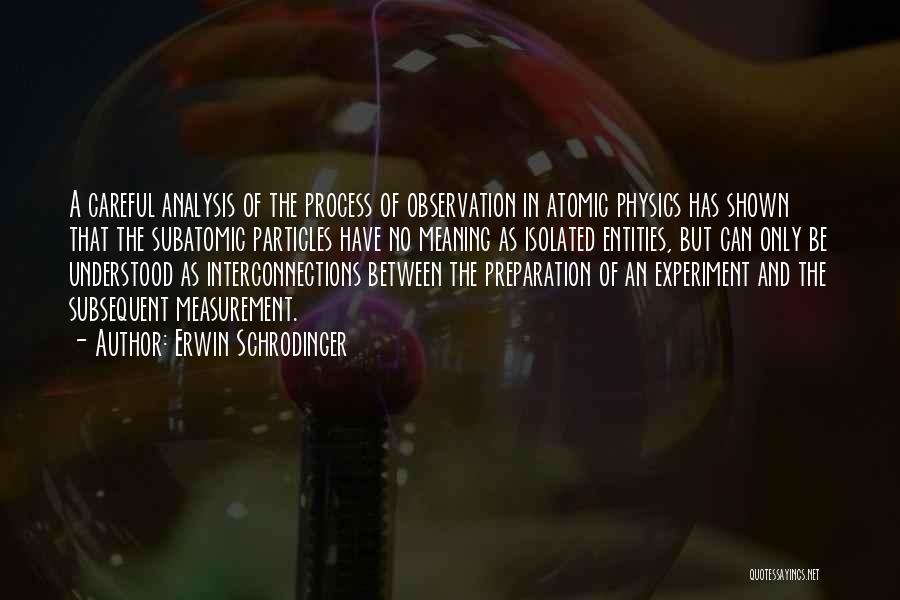
A careful analysis of the process of observation in atomic physics has shown that the subatomic particles have no meaning as isolated entities, but can only be understood as interconnections between the preparation of an experiment and the subsequent measurement. — Erwin Schrodinger
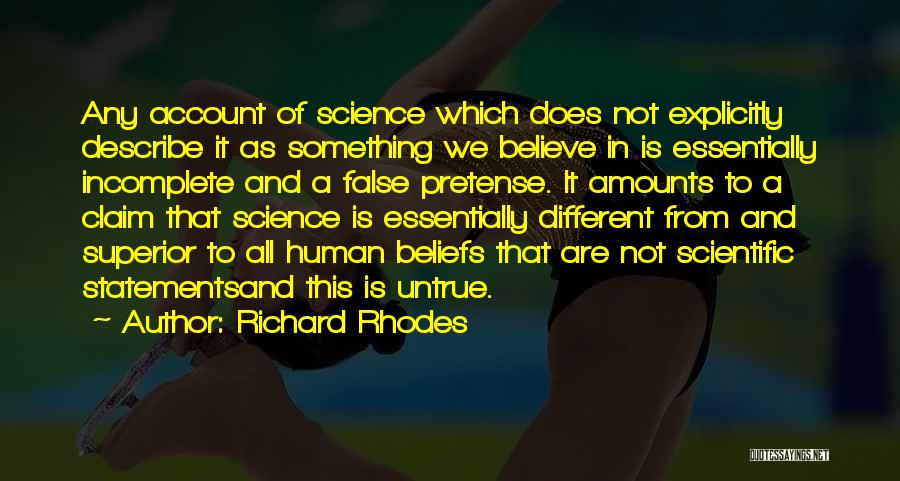
Any account of science which does not explicitly describe it as something we believe in is essentially incomplete and a false pretense. It amounts to a claim that science is essentially different from and superior to all human beliefs that are not scientific statements
and this is untrue. — Richard Rhodes
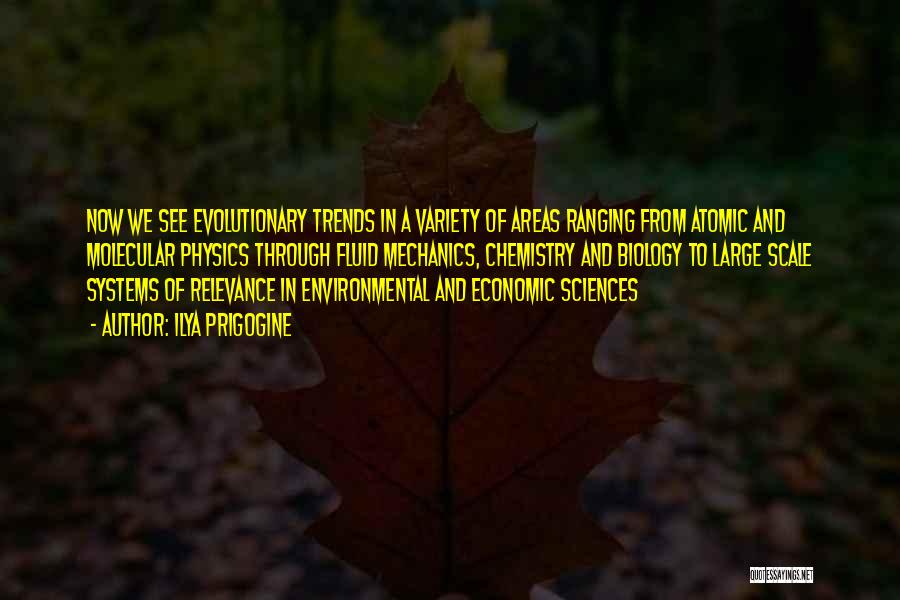
Now we see evolutionary trends in a variety of areas ranging from atomic and molecular physics through fluid mechanics, chemistry and biology to large scale systems of relevance in environmental and economic sciences — Ilya Prigogine
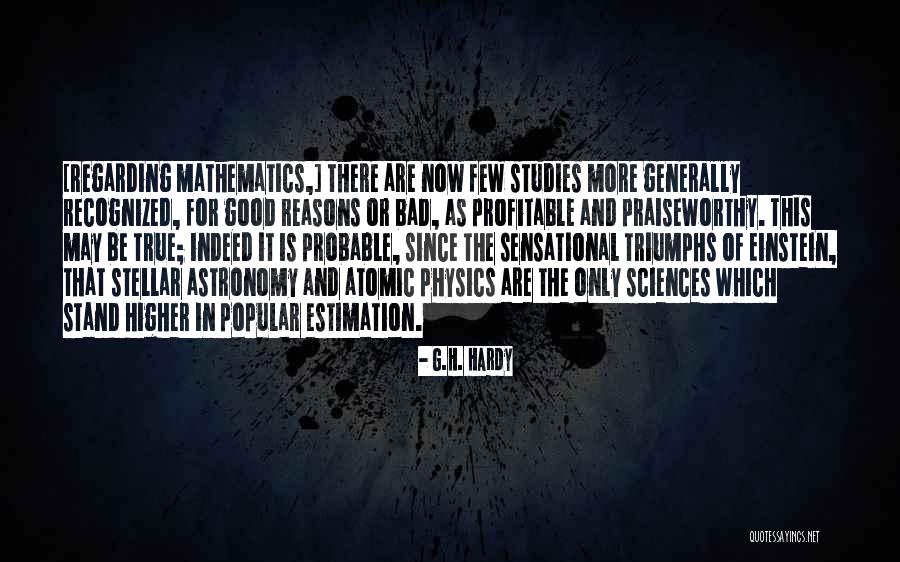
[Regarding mathematics,] there are now few studies more generally recognized, for good reasons or bad, as profitable and praiseworthy. This may be true; indeed it is probable, since the sensational triumphs of Einstein, that stellar astronomy and atomic physics are the only sciences which stand higher in popular estimation. — G.H. Hardy
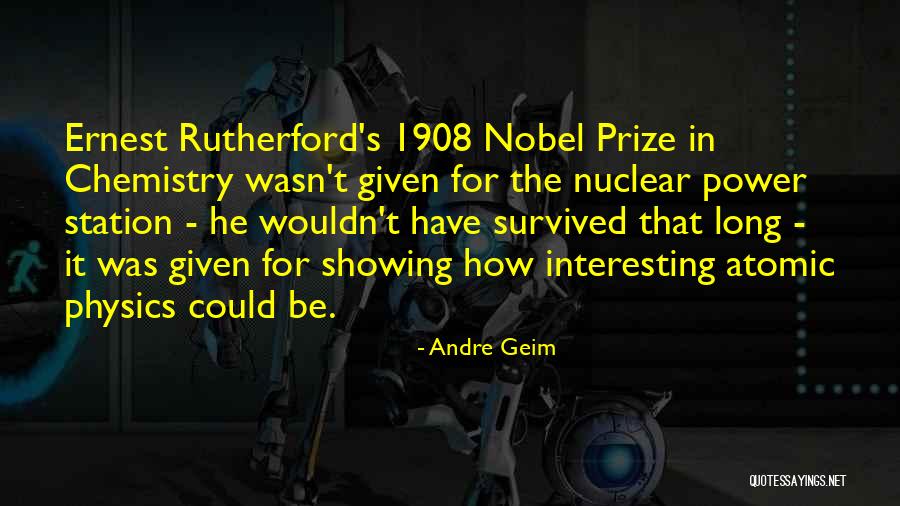
Ernest Rutherford's 1908 Nobel Prize in Chemistry wasn't given for the nuclear power station - he wouldn't have survived that long - it was given for showing how interesting atomic physics could be. — Andre Geim
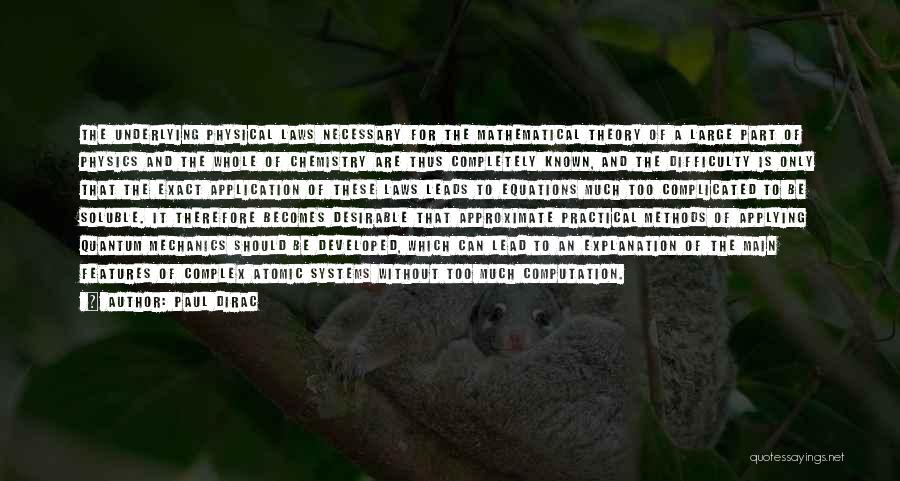
The underlying physical laws necessary for the mathematical theory of a large part of physics and the whole of chemistry are thus completely known, and the difficulty is only that the exact application of these laws leads to equations much too complicated to be soluble. It therefore becomes desirable that approximate practical methods of applying quantum mechanics should be developed, which can lead to an explanation of the main features of complex atomic systems without too much computation. — Paul Dirac
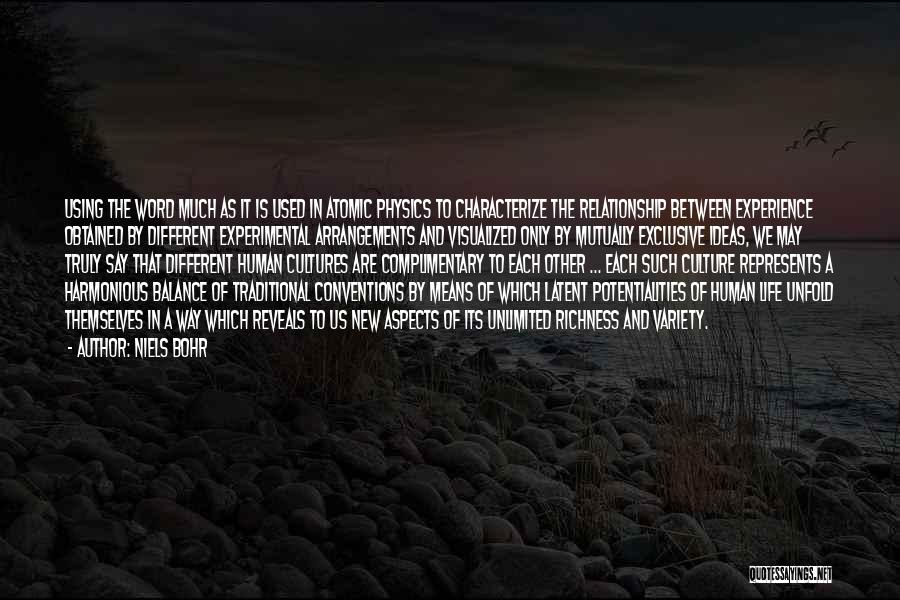
Using the word much as it is used in atomic physics to characterize the relationship between experience obtained by different experimental arrangements and visualized only by mutually exclusive ideas, we may truly say that different human cultures are complimentary to each other ... each such culture represents a harmonious balance of traditional conventions by means of which latent potentialities of human life unfold themselves in a way which reveals to us new aspects of its unlimited richness and variety. — Niels Bohr
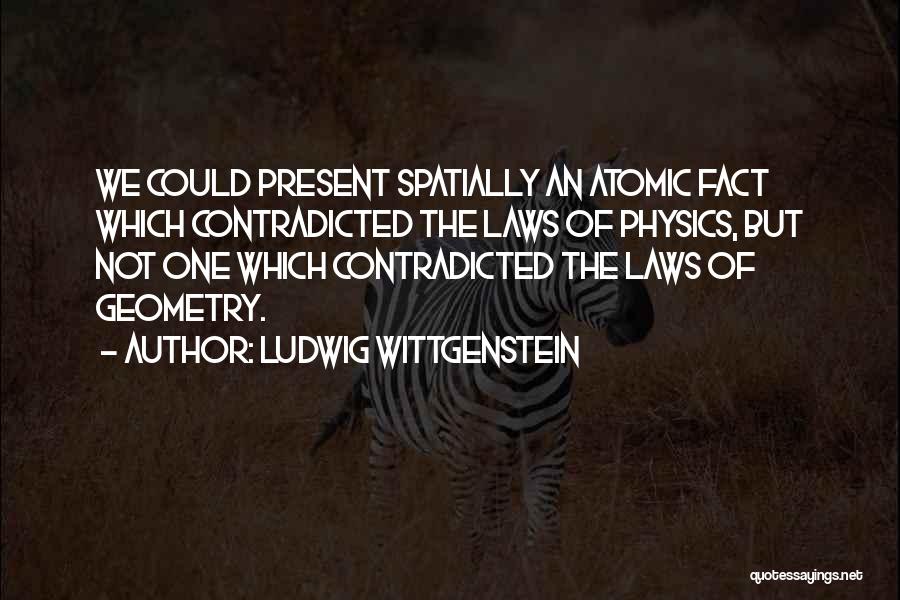
We could present spatially an atomic fact which contradicted the laws of physics, but not one which contradicted the laws of geometry. — Ludwig Wittgenstein
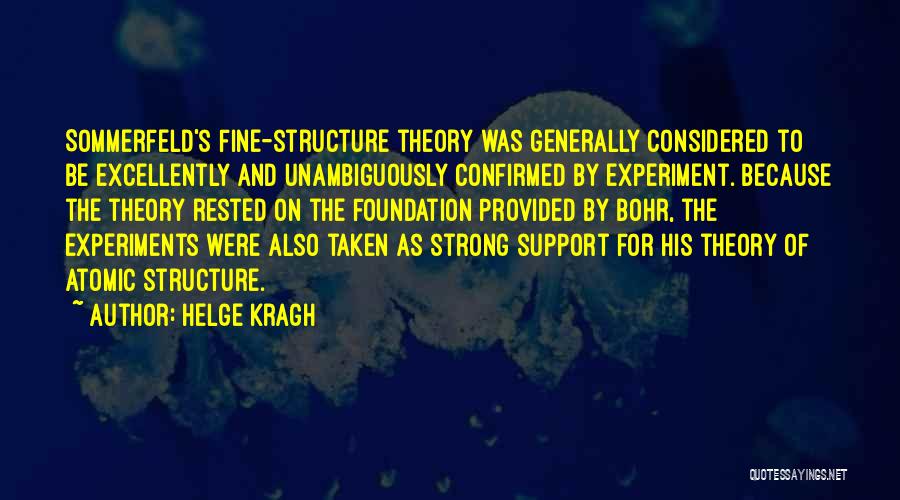
Sommerfeld's fine-structure theory was generally considered to be excellently and unambiguously confirmed by experiment. Because the theory rested on the foundation provided by Bohr, the experiments were also taken as strong support for his theory of atomic structure. — Helge Kragh
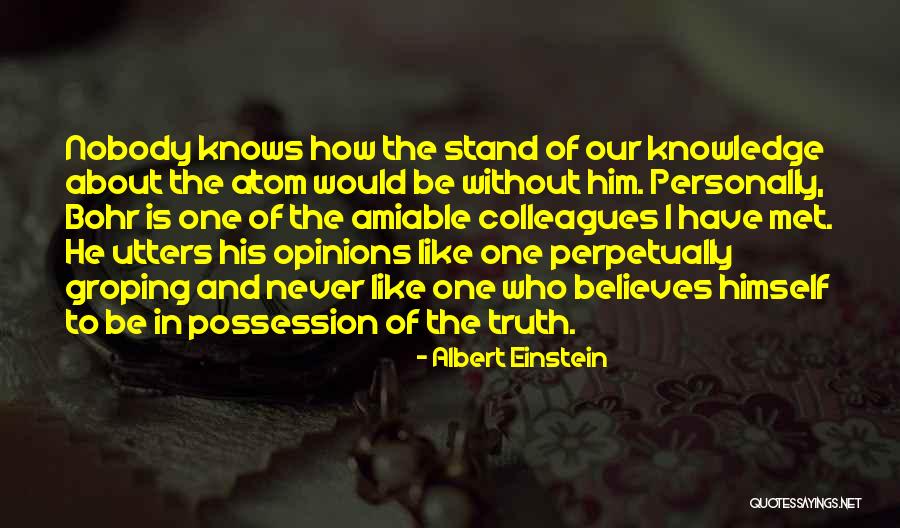
Nobody knows how the stand of our knowledge about the atom would be without him. Personally, Bohr is one of the amiable colleagues I have met. He utters his opinions like one perpetually groping and never like one who believes himself to be in possession of the truth. — Albert Einstein
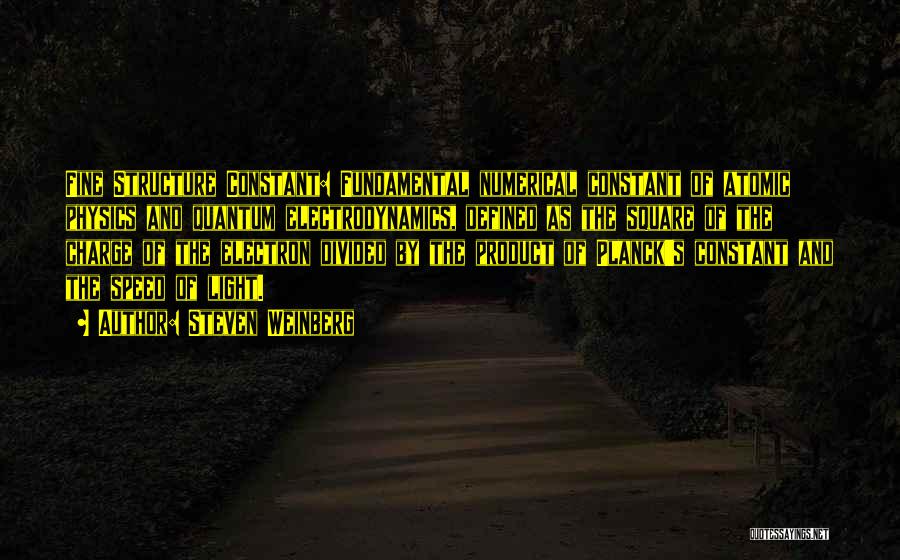
Fine Structure Constant: Fundamental numerical constant of atomic physics and quantum electrodynamics, defined as the square of the charge of the electron divided by the product of Planck's constant and the speed of light. — Steven Weinberg
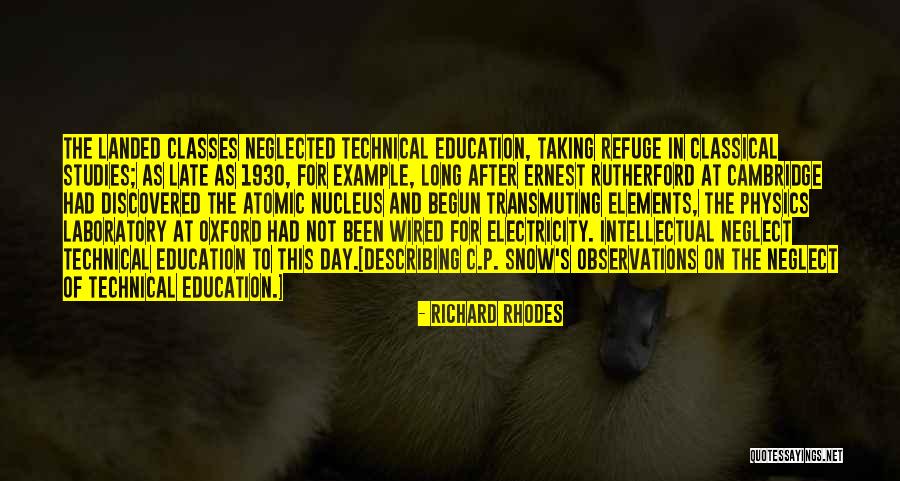
The landed classes neglected technical education, taking refuge in classical studies; as late as 1930, for example, long after Ernest Rutherford at Cambridge had discovered the atomic nucleus and begun transmuting elements, the physics laboratory at Oxford had not been wired for electricity. Intellectual neglect technical education to this day.
[Describing C.P. Snow's observations on the neglect of technical education.] — Richard Rhodes
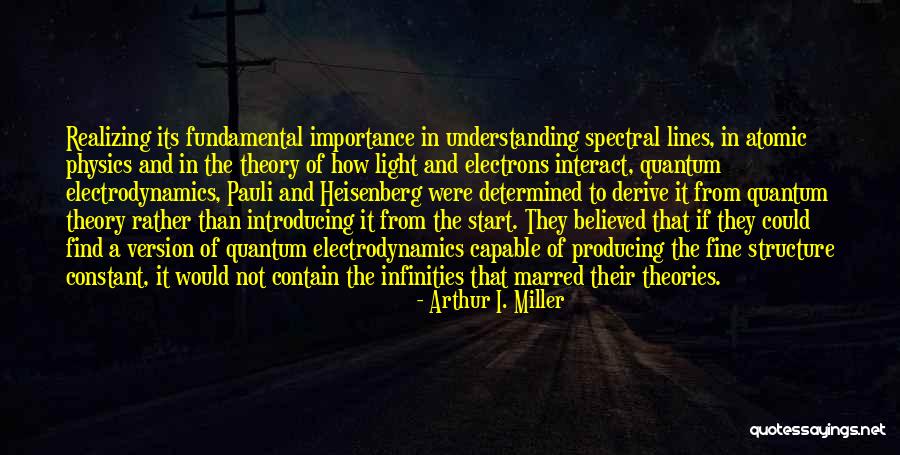
Realizing its fundamental importance in understanding spectral lines, in atomic physics and in the theory of how light and electrons interact, quantum electrodynamics, Pauli and Heisenberg were determined to derive it from quantum theory rather than introducing it from the start. They believed that if they could find a version of quantum electrodynamics capable of producing the fine structure constant, it would not contain the infinities that marred their theories. — Arthur I. Miller
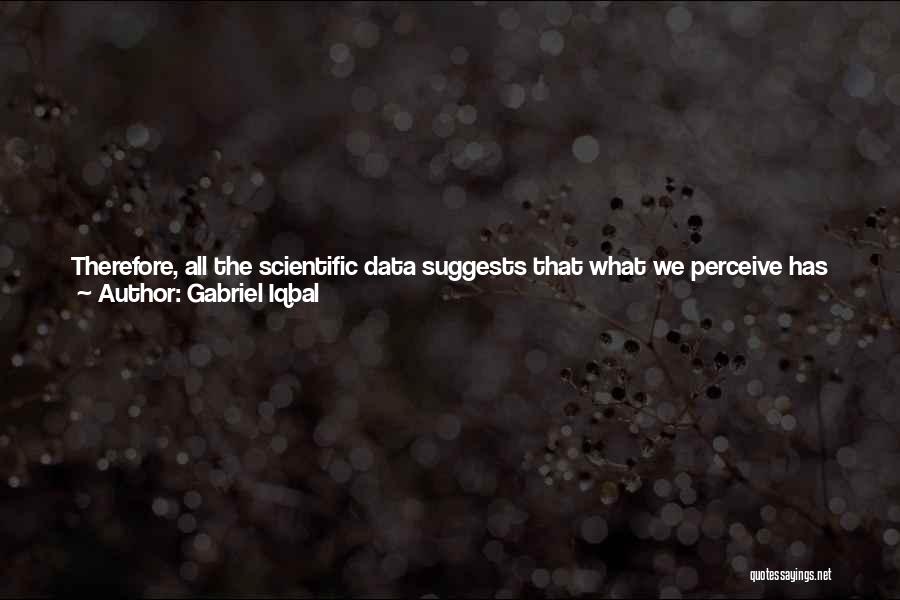
Therefore, all the scientific data suggests that what we perceive has an effect on matter as we view it. We are co-creating this universe as participators. So if we are looking at the smallest sub-atomic particles and/or the edge of the universe we bring about the act of creation just by observing hence we will never find the smallest subatomic particles or the edge of the universe as we are co-creating reality. Hence the dilemma, if there is an edge of the universe, what is beyond the edge or if we have found the smallest sub-atomic particle what is it further made up of. I can sum up my research by stating that the very act of observation creates reality. — Gabriel Iqbal
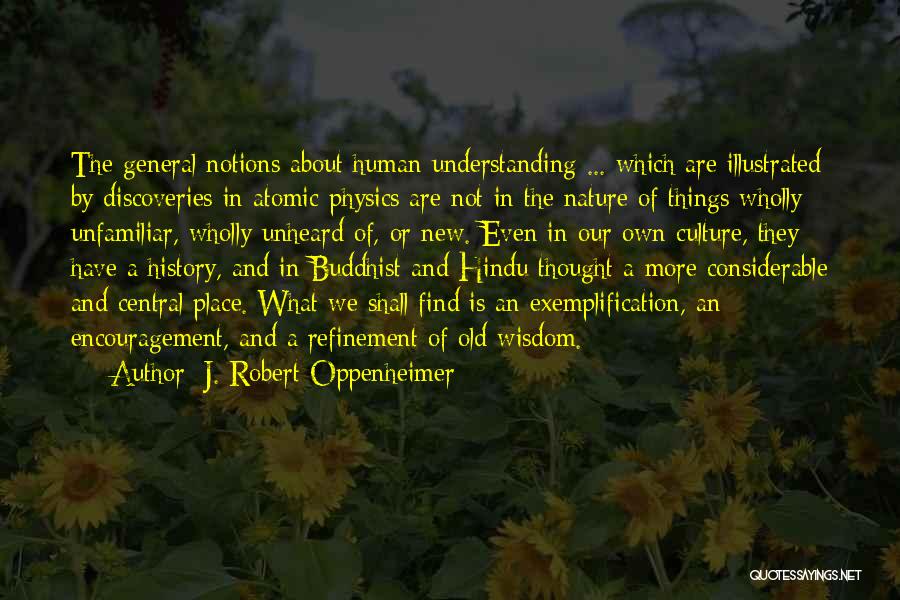
The general notions about human understanding ... which are illustrated by discoveries in atomic physics are not in the nature of things wholly unfamiliar, wholly unheard of, or new. Even in our own culture, they have a history, and in Buddhist and Hindu thought a more considerable and central place. What we shall find is an exemplification, an encouragement, and a refinement of old wisdom. — J. Robert Oppenheimer
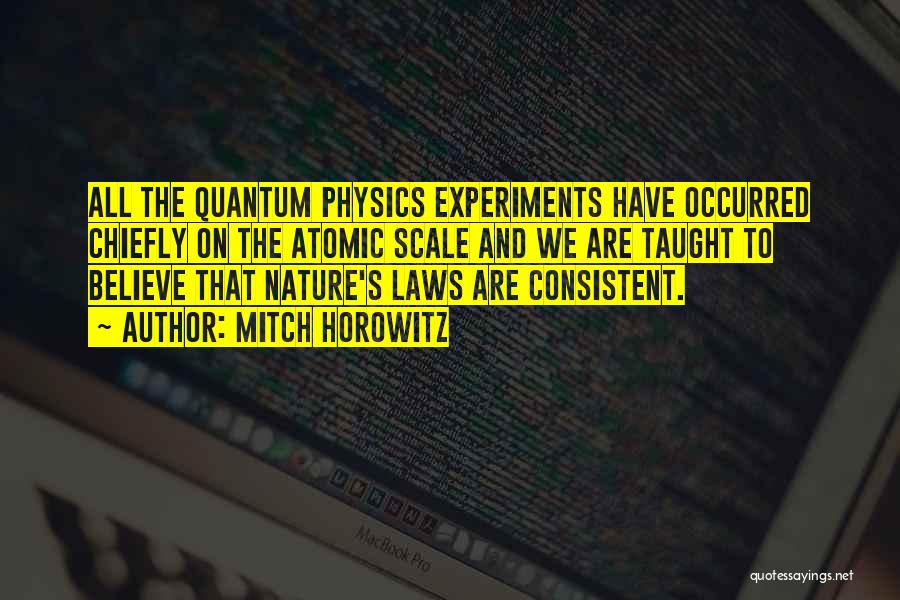
All the quantum physics experiments have occurred chiefly on the atomic scale and we are taught to believe that nature's laws are consistent. — Mitch Horowitz

But even physics cannot be defined from an atomic topography. — Michael Polanyi
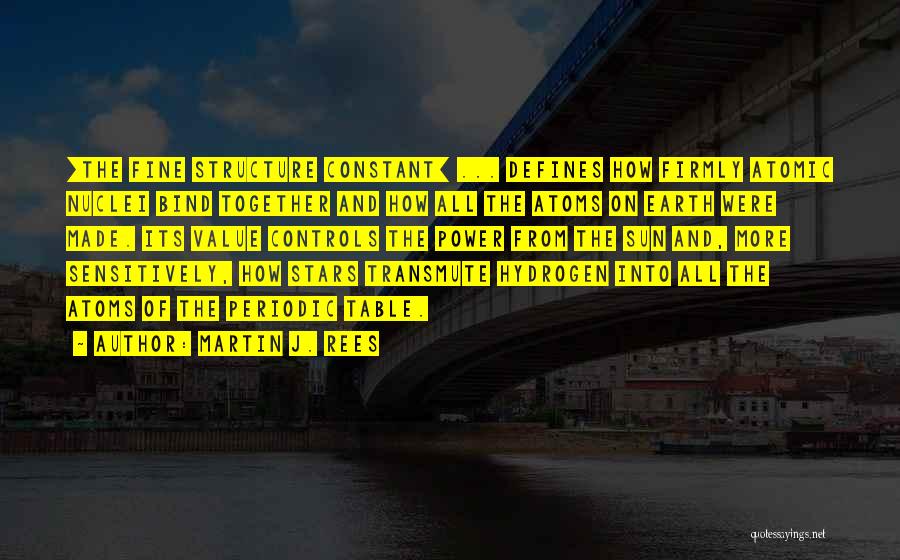
[The fine structure constant] ... defines how firmly atomic nuclei bind together and how all the atoms on Earth were made. Its value controls the power from the Sun and, more sensitively, how stars transmute hydrogen into all the atoms of the periodic table. — Martin J. Rees
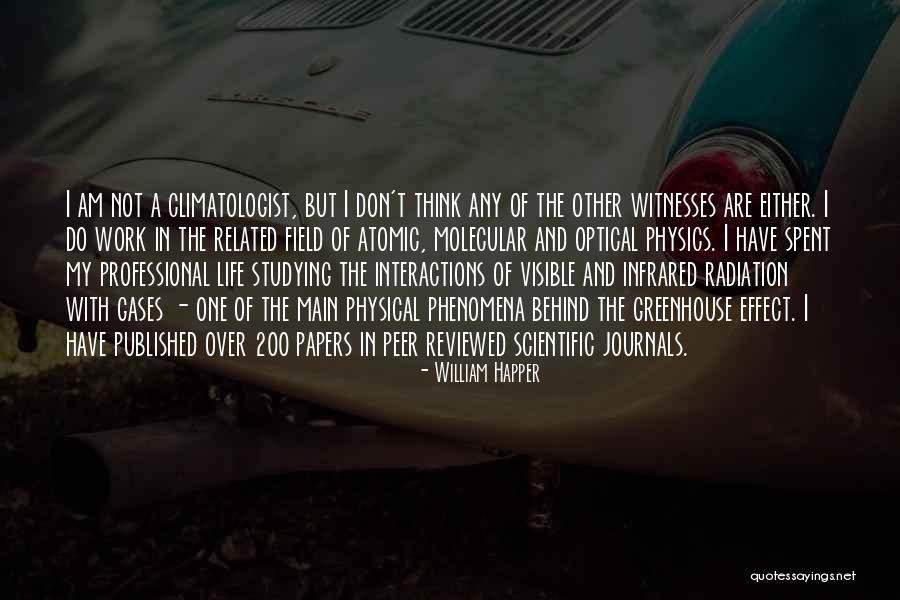
I am not a climatologist, but I don't think any of the other witnesses are either. I do work in the related field of atomic, molecular and optical physics. I have spent my professional life studying the interactions of visible and infrared radiation with gases - one of the main physical phenomena behind the greenhouse effect. I have published over 200 papers in peer reviewed scientific journals. — William Happer
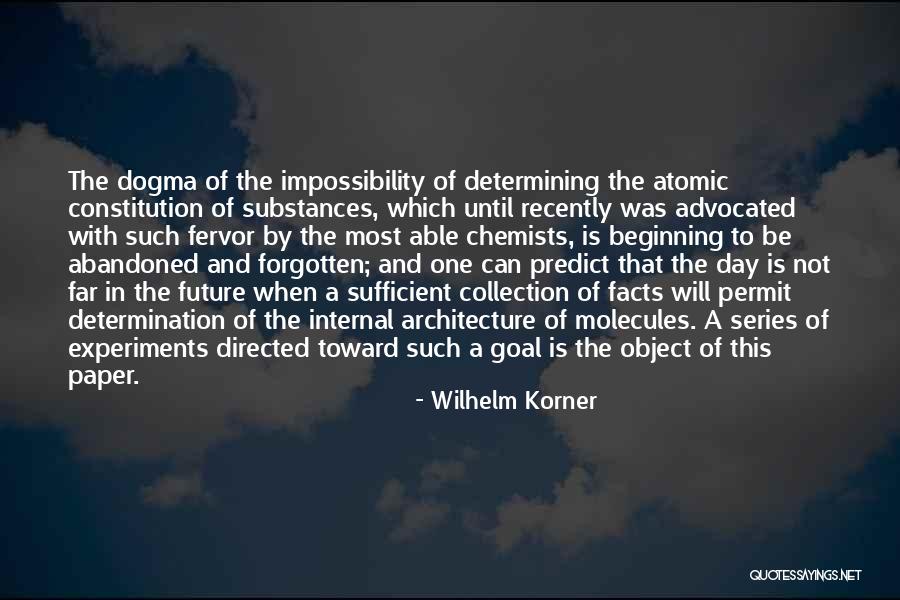
The dogma of the impossibility of determining the atomic constitution of substances, which until recently was advocated with such fervor by the most able chemists, is beginning to be abandoned and forgotten; and one can predict that the day is not far in the future when a sufficient collection of facts will permit determination of the internal architecture of molecules. A series of experiments directed toward such a goal is the object of this paper. — Wilhelm Korner
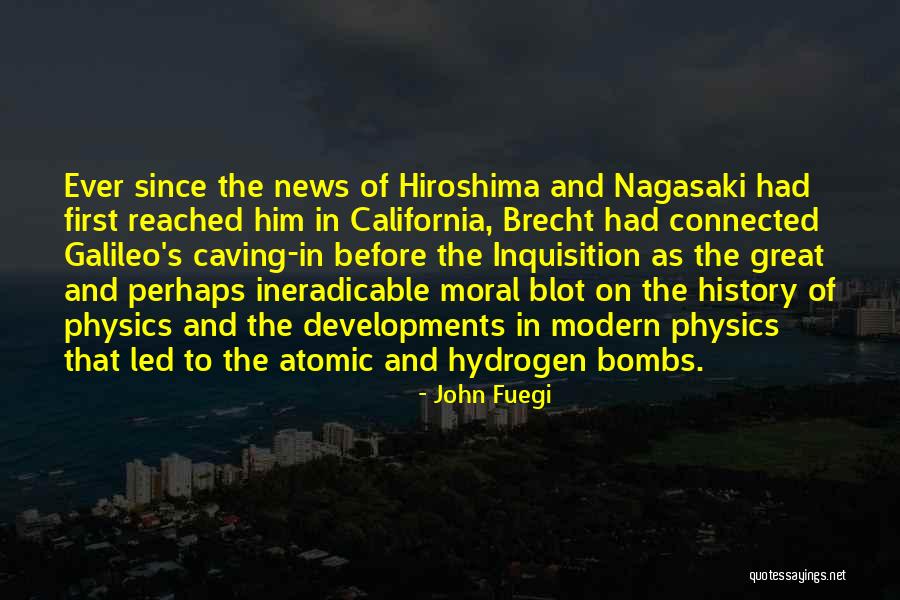
Ever since the news of Hiroshima and Nagasaki had first reached him in California, Brecht had connected Galileo's caving-in before the Inquisition as the great and perhaps ineradicable moral blot on the history of physics and the developments in modern physics that led to the atomic and hydrogen bombs. — John Fuegi
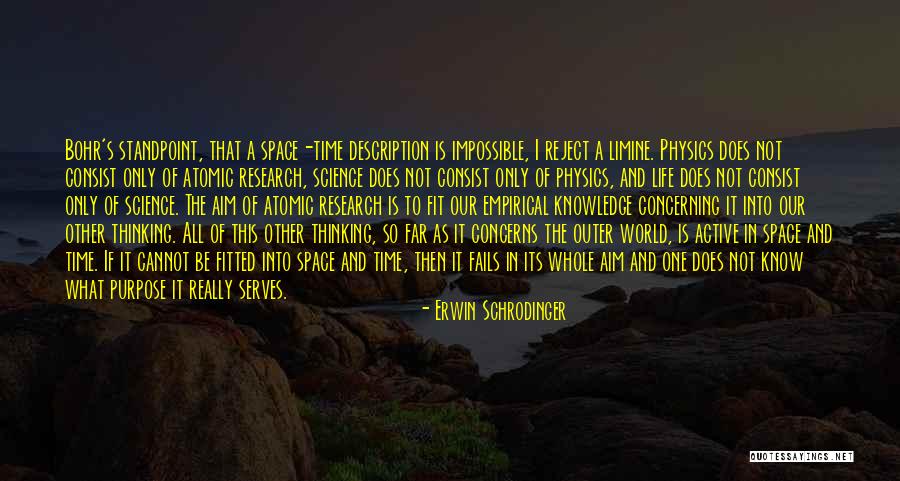
Bohr's standpoint, that a space-time description is impossible, I reject a limine. Physics does not consist only of atomic research, science does not consist only of physics, and life does not consist only of science. The aim of atomic research is to fit our empirical knowledge concerning it into our other thinking. All of this other thinking, so far as it concerns the outer world, is active in space and time. If it cannot be fitted into space and time, then it fails in its whole aim and one does not know what purpose it really serves. — Erwin Schrodinger
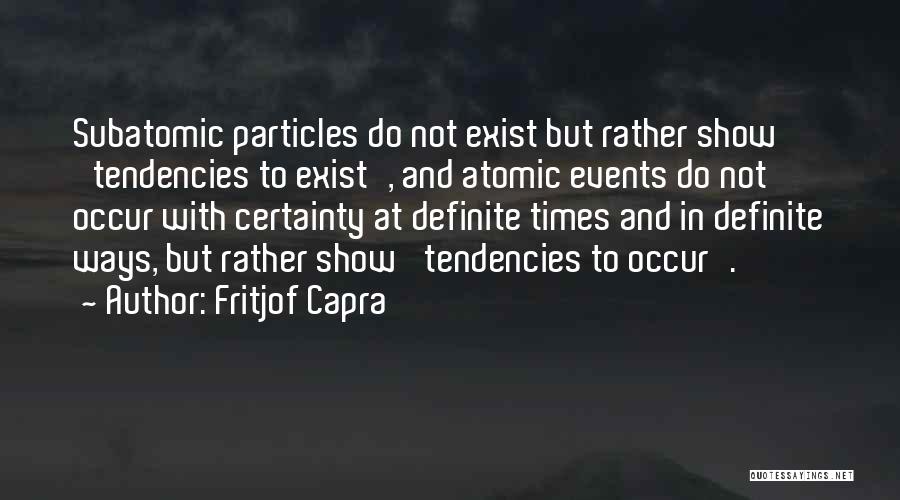
Subatomic particles do not exist but rather show 'tendencies to exist', and atomic events do not occur with certainty at definite times and in definite ways, but rather show 'tendencies to occur'. — Fritjof Capra
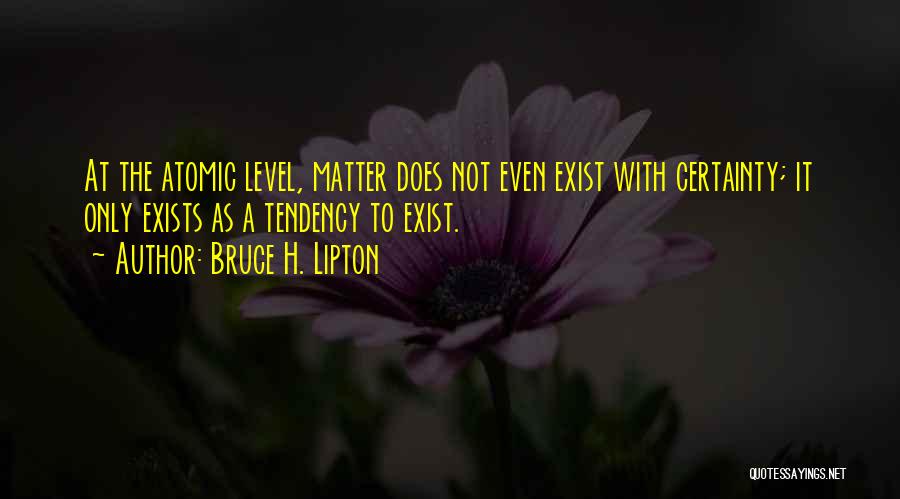
At the atomic level, matter does not even exist with certainty; it only exists as a tendency to exist. — Bruce H. Lipton
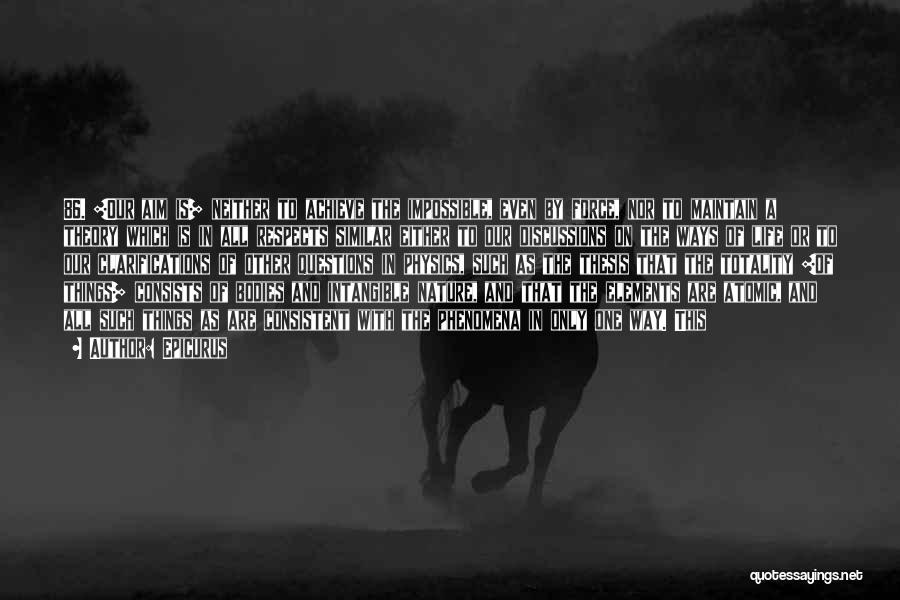
86. [Our aim is] neither to achieve the impossible, even by force, nor to maintain a theory which is in all respects similar either to our discussions on the ways of life or to our clarifications of other questions in physics, such as the thesis that the totality [of things] consists of bodies and intangible nature, and that the elements are atomic, and all such things as are consistent with the phenomena in only one way. This — Epicurus

We walked up and down in the snow, I on skis and she on foot (she said and proved that she could get along just as fast that way), and gradually the idea took shape that this was no chipping or cracking of the nucleus but rather a process to be explained by Bohr's idea that the nucleus was like a liquid drop; such a drop might elongate and divide itself.
{On his aunt and fellow science Lise Meitner} — Otto Robert Frisch
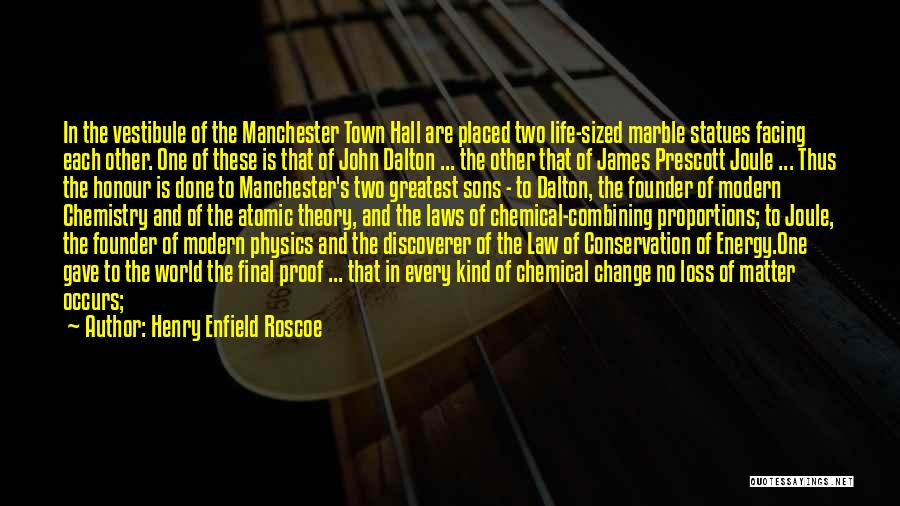
In the vestibule of the Manchester Town Hall are placed two life-sized marble statues facing each other. One of these is that of John Dalton ... the other that of James Prescott Joule ... Thus the honour is done to Manchester's two greatest sons - to Dalton, the founder of modern Chemistry and of the atomic theory, and the laws of chemical-combining proportions; to Joule, the founder of modern physics and the discoverer of the Law of Conservation of Energy.
One gave to the world the final proof ... that in every kind of chemical change no loss of matter occurs; the other proved that in all the varied modes of physical change, no loss of energy takes place. — Henry Enfield Roscoe
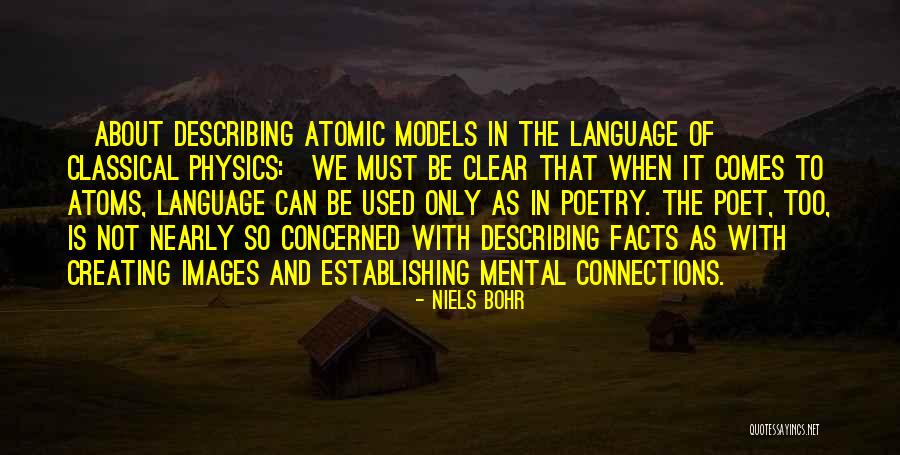
[About describing atomic models in the language of classical physics:]
We must be clear that when it comes to atoms, language can be used only as in poetry. The poet, too, is not nearly so concerned with describing facts as with creating images and establishing mental connections. — Niels Bohr

A billion neutrinos go swimming in heavy water: one gets wet. — Michael Kamakana
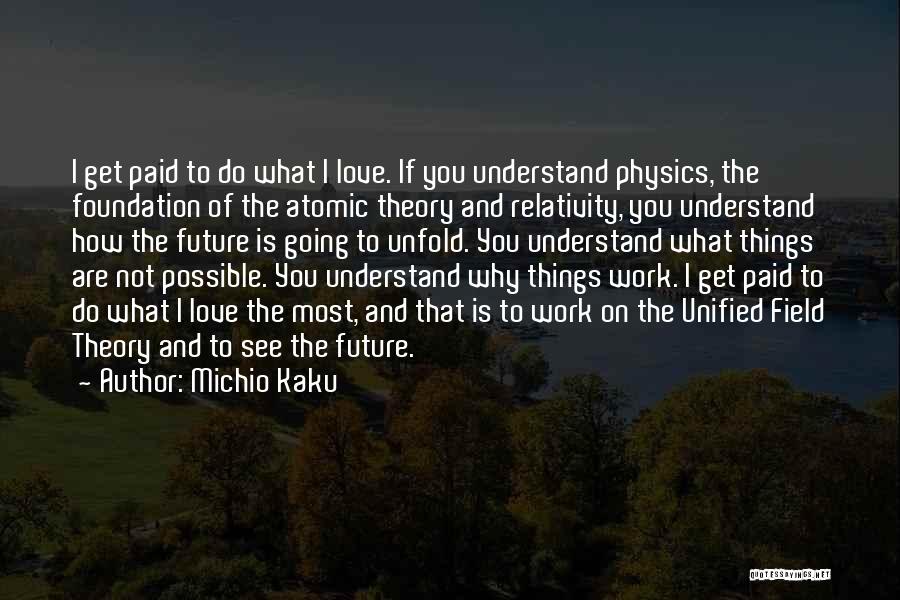
I get paid to do what I love. If you understand physics, the foundation of the atomic theory and relativity, you understand how the future is going to unfold. You understand what things are not possible. You understand why things work. I get paid to do what I love the most, and that is to work on the Unified Field Theory and to see the future. — Michio Kaku
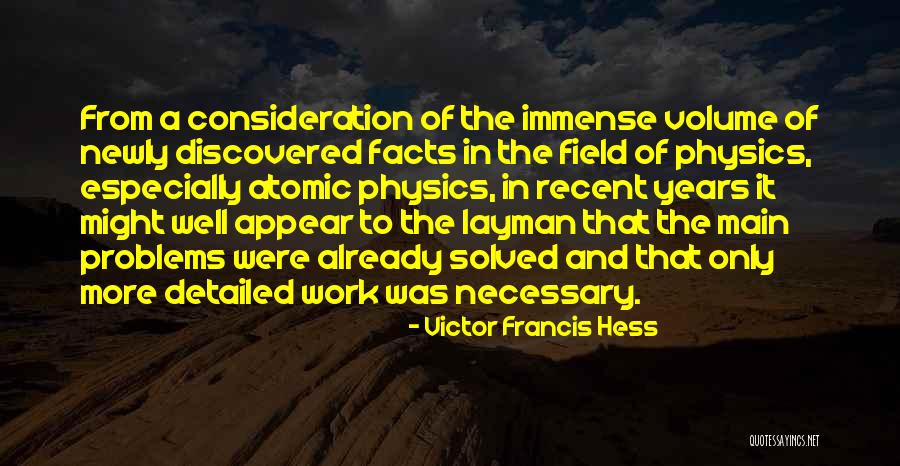
From a consideration of the immense volume of newly discovered facts in the field of physics, especially atomic physics, in recent years it might well appear to the layman that the main problems were already solved and that only more detailed work was necessary. — Victor Francis Hess
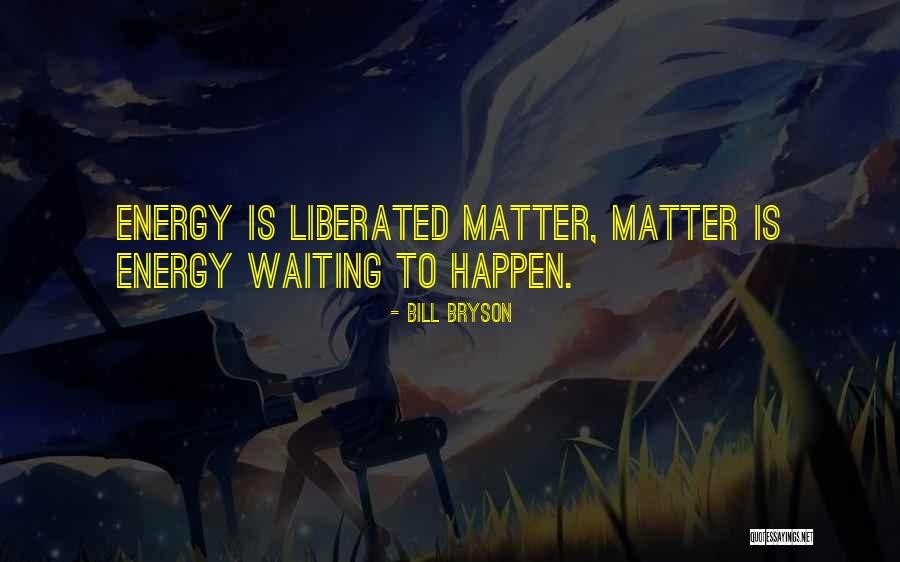
Energy is liberated matter, matter is energy waiting to happen. — Bill Bryson
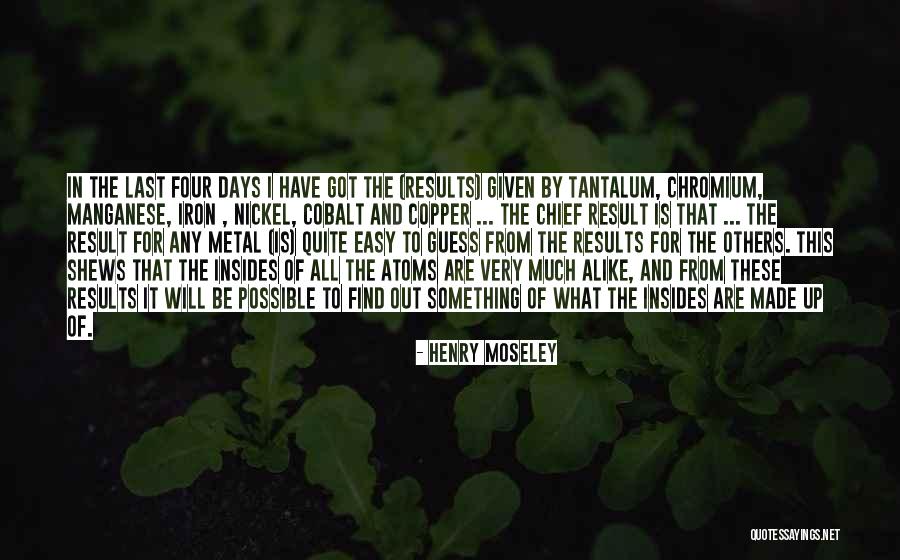
In the last four days I have got the (results) given by Tantalum, Chromium, Manganese, Iron , Nickel, Cobalt and Copper ... The chief result is that ... the result for any metal (is) quite easy to guess from the results for the others. This shews that the insides of all the atoms are very much alike, and from these results it will be possible to find out something of what the insides are made up of. — Henry Moseley
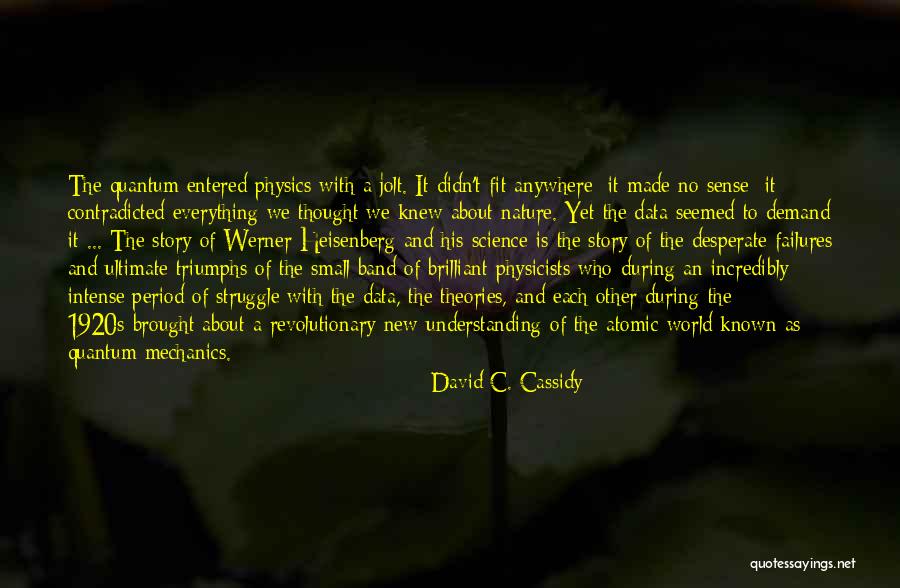
The quantum entered physics with a jolt. It didn't fit anywhere; it made no sense; it contradicted everything we thought we knew about nature. Yet the data seemed to demand it ... The story of Werner Heisenberg and his science is the story of the desperate failures and ultimate triumphs of the small band of brilliant physicists who-during an incredibly intense period of struggle with the data, the theories, and each other during the 1920s-brought about a revolutionary new understanding of the atomic world known as quantum mechanics. — David C. Cassidy
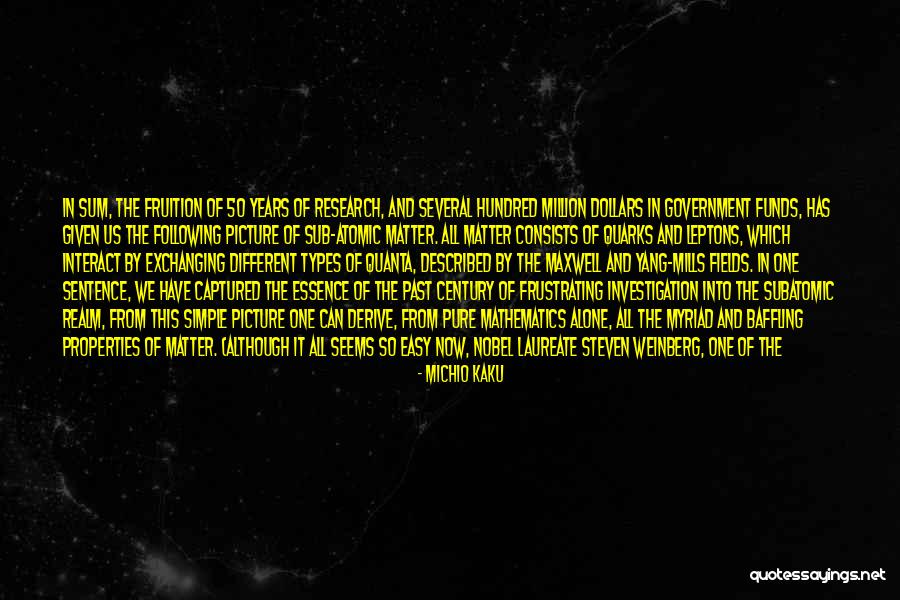
In sum, the fruition of 50 years of research, and several hundred million dollars in government funds, has given us the following picture of sub-atomic matter. All matter consists of quarks and leptons, which interact by exchanging different types of quanta, described by the Maxwell and Yang-Mills fields. In one sentence, we have captured the essence of the past century of frustrating investigation into the subatomic realm, From this simple picture one can derive, from pure mathematics alone, all the myriad and baffling properties of matter. (Although it all seems so easy now, Nobel laureate Steven Weinberg, one of the creators of the Standard Model, once reflected on how tortuous the 50-year journey to discover the model had been. He wrote, "There's a long tradition of theoretical physics, which by no means affected everyone but certainly affected me, that said the strong interactions [were] too complicated for the human mind.") — Michio Kaku
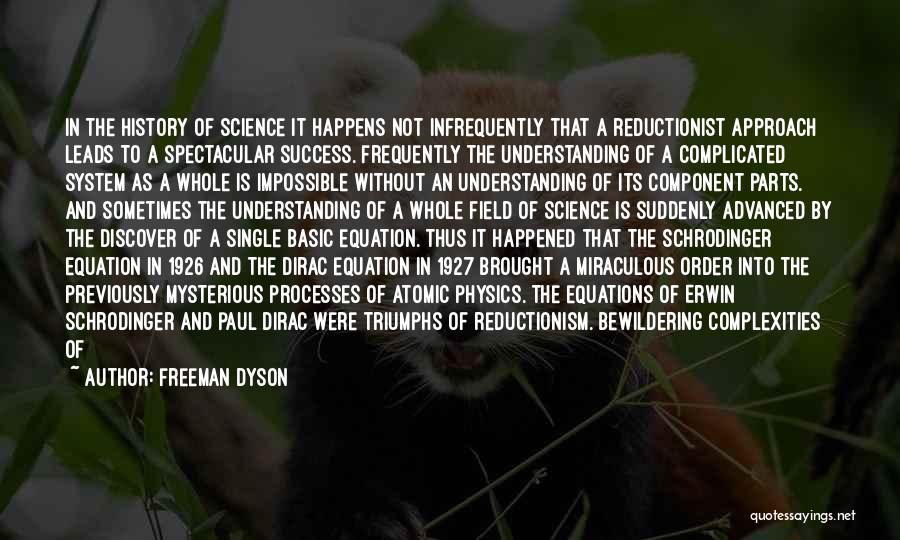
In the history of science it happens not infrequently that a reductionist approach leads to a spectacular success. Frequently the understanding of a complicated system as a whole is impossible without an understanding of its component parts. And sometimes the understanding of a whole field of science is suddenly advanced by the discover of a single basic equation. Thus it happened that the Schrodinger equation in 1926 and the Dirac equation in 1927 brought a miraculous order into the previously mysterious processes of atomic physics. The equations of Erwin Schrodinger and Paul Dirac were triumphs of reductionism. Bewildering complexities of chemistry and physics were reduced to two lines of algebraic symbols. These triumphs were in Oppenheimer's mind when he belittled his own discovery of black holes. Compared with the abstract beauty and simplicity of the Dirac equation, the black hole solution seemed to him ugly, complicated, and lacking in fundamental significance. — Freeman Dyson
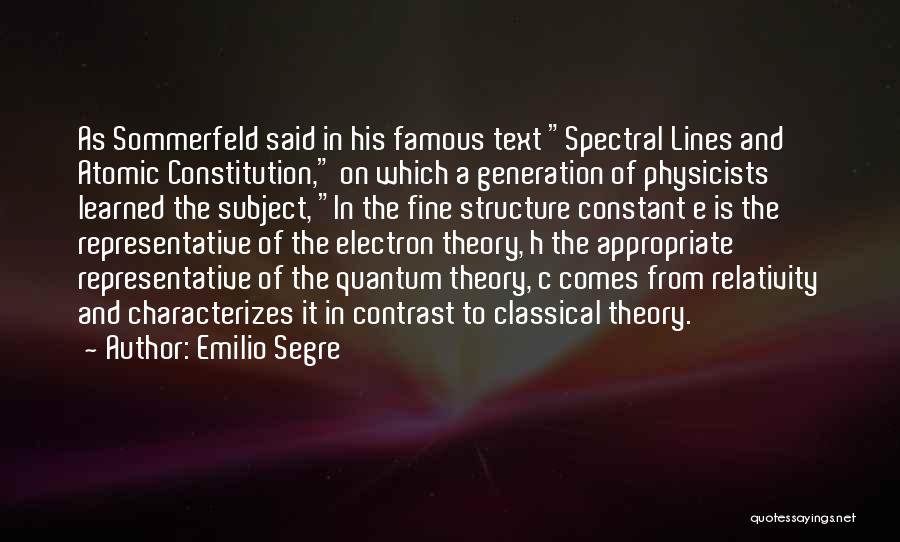
As Sommerfeld said in his famous text "Spectral Lines and Atomic Constitution," on which a generation of physicists learned the subject, "In the fine structure constant e is the representative of the electron theory, h the appropriate representative of the quantum theory, c comes from relativity and characterizes it in contrast to classical theory. — Emilio Segre
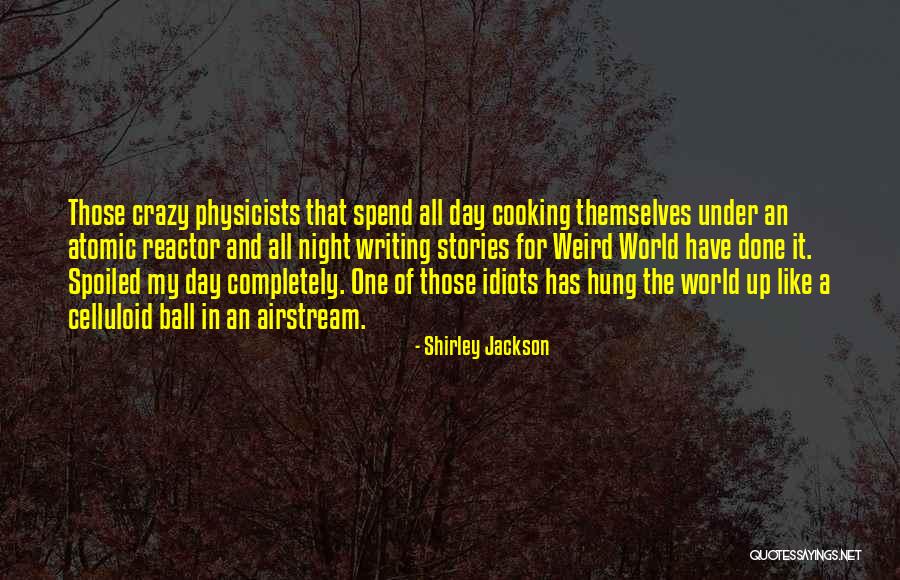
Those crazy physicists that spend all day cooking themselves under an atomic reactor and all night writing stories for Weird World have done it. Spoiled my day completely. One of those idiots has hung the world up like a celluloid ball in an airstream. — Shirley Jackson
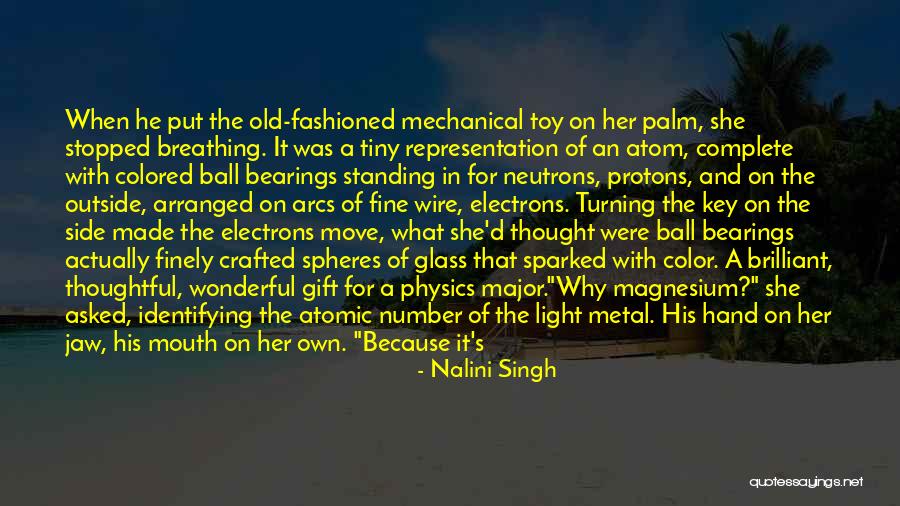
When he put the old-fashioned mechanical toy on her palm, she stopped breathing. It was a tiny representation of an atom, complete with colored ball bearings standing in for neutrons, protons, and on the outside, arranged on arcs of fine wire, electrons. Turning the key on the side made the electrons move, what she'd thought were ball bearings actually finely crafted spheres of glass that sparked with color. A brilliant, thoughtful, wonderful gift for a physics major.
"Why magnesium?" she asked, identifying the atomic number of the light metal. His hand on her jaw, his mouth on her own. "Because it's beautifully explosive, just like my X. — Nalini Singh
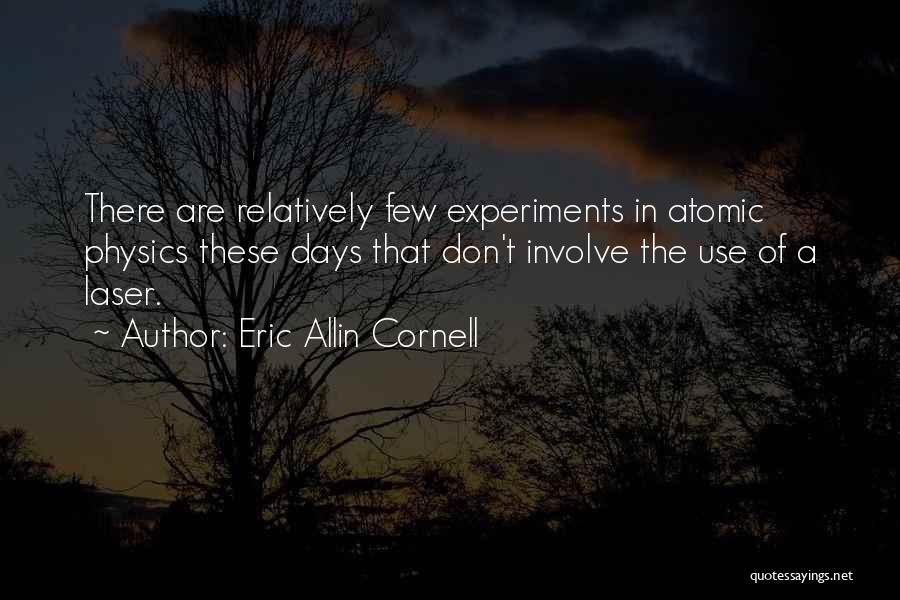
There are relatively few experiments in atomic physics these days that don't involve the use of a laser. — Eric Allin Cornell
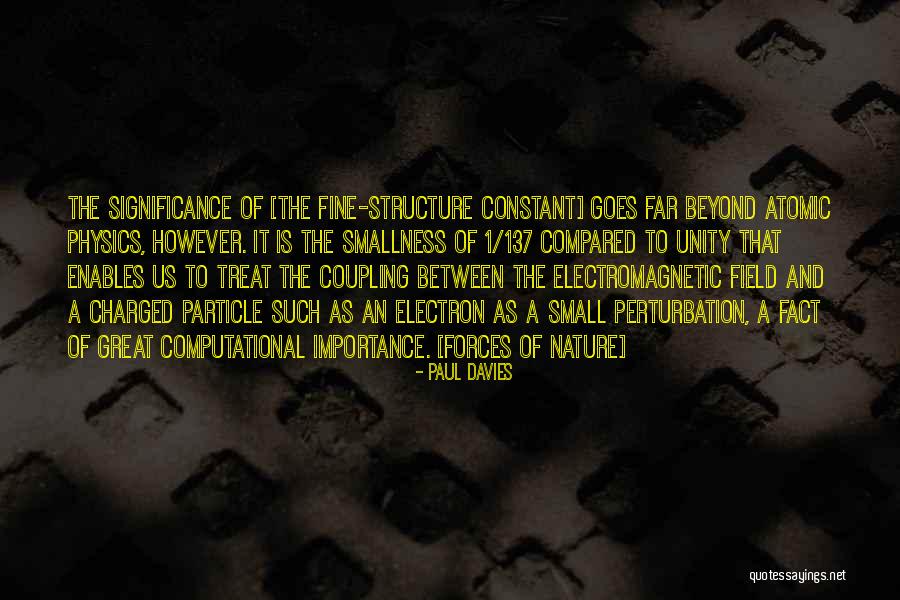
The significance of [the fine-structure constant] goes far beyond atomic physics, however. It is the smallness of 1/137 compared to unity that enables us to treat the coupling between the electromagnetic field and a charged particle such as an electron as a small perturbation, a fact of great computational importance. [Forces of Nature] — Paul Davies
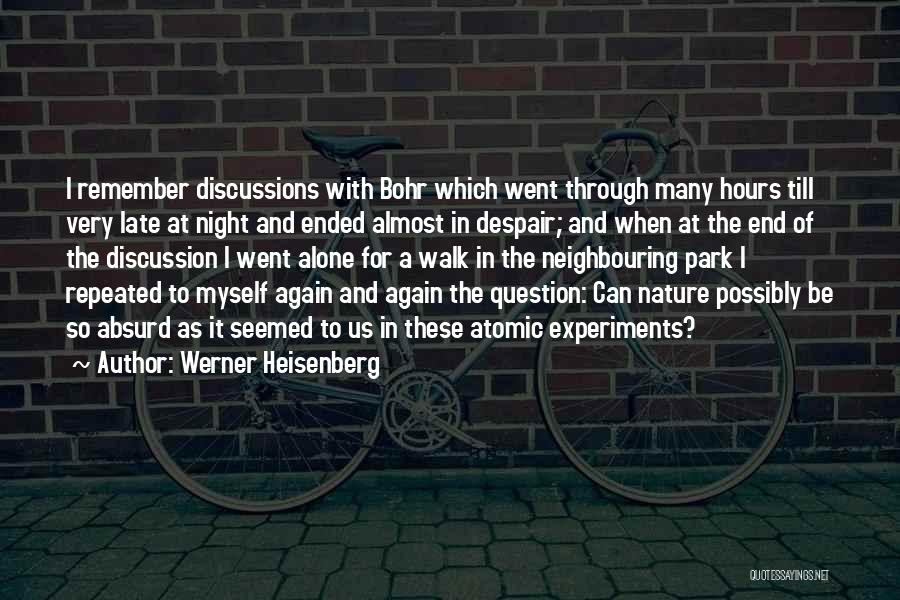
I remember discussions with Bohr which went through many hours till very late at night and ended almost in despair; and when at the end of the discussion I went alone for a walk in the neighbouring park I repeated to myself again and again the question: Can nature possibly be so absurd as it seemed to us in these atomic experiments? — Werner Heisenberg
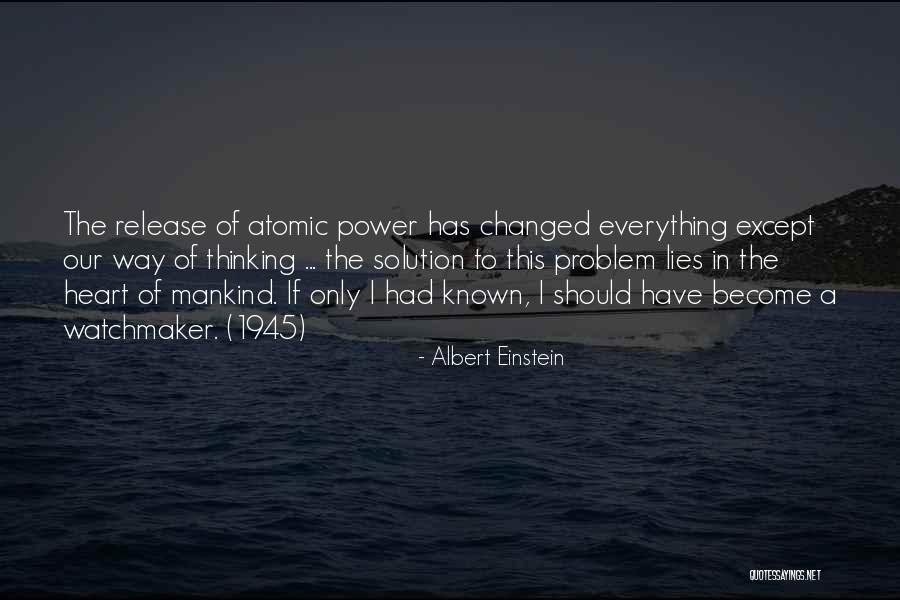
The release of atomic power has changed everything except our way of thinking ... the solution to this problem lies in the heart of mankind. If only I had known, I should have become a watchmaker. (1945) — Albert Einstein
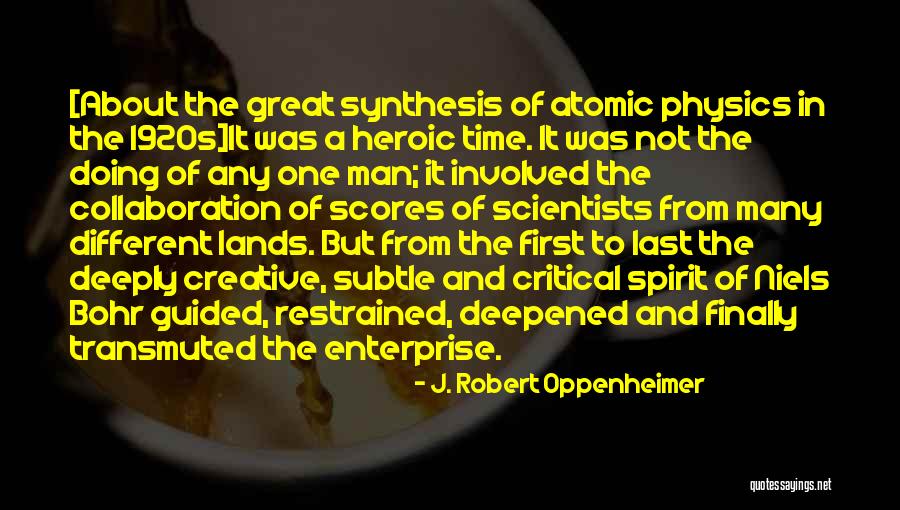
[About the great synthesis of atomic physics in the 1920s]
It was a heroic time. It was not the doing of any one man; it involved the collaboration of scores of scientists from many different lands. But from the first to last the deeply creative, subtle and critical spirit of Niels Bohr guided, restrained, deepened and finally transmuted the enterprise. — J. Robert Oppenheimer
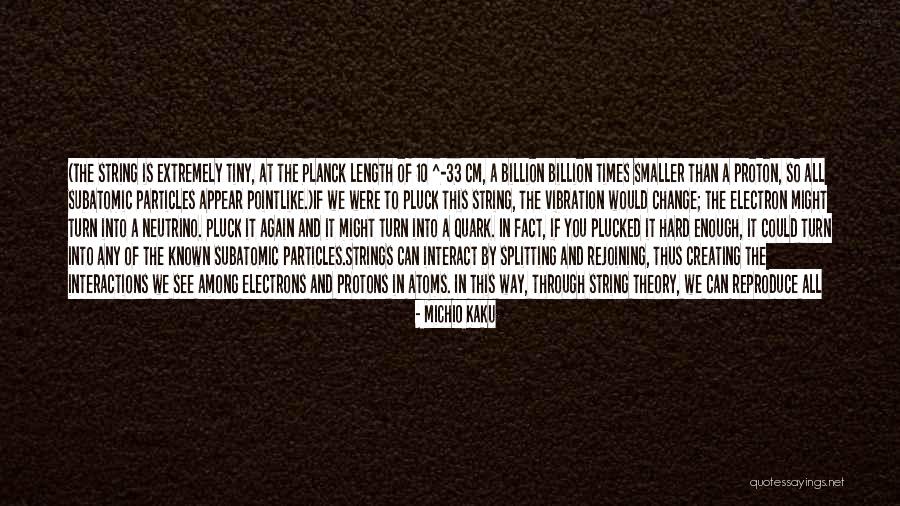
(The string is extremely tiny, at the Planck length of 10 ^-33 cm, a billion billion times smaller than a proton, so all subatomic particles appear pointlike.)
If we were to pluck this string, the vibration would change; the electron might turn into a neutrino. Pluck it again and it might turn into a quark. In fact, if you plucked it hard enough, it could turn into any of the known subatomic particles.
Strings can interact by splitting and rejoining, thus creating the interactions we see among electrons and protons in atoms. In this way, through string theory, we can reproduce all the laws of atomic and nuclear physics. The "melodies" that can be written on strings correspond to the laws of chemistry. The universe can now be viewed as a vast symphony of strings. — Michio Kaku
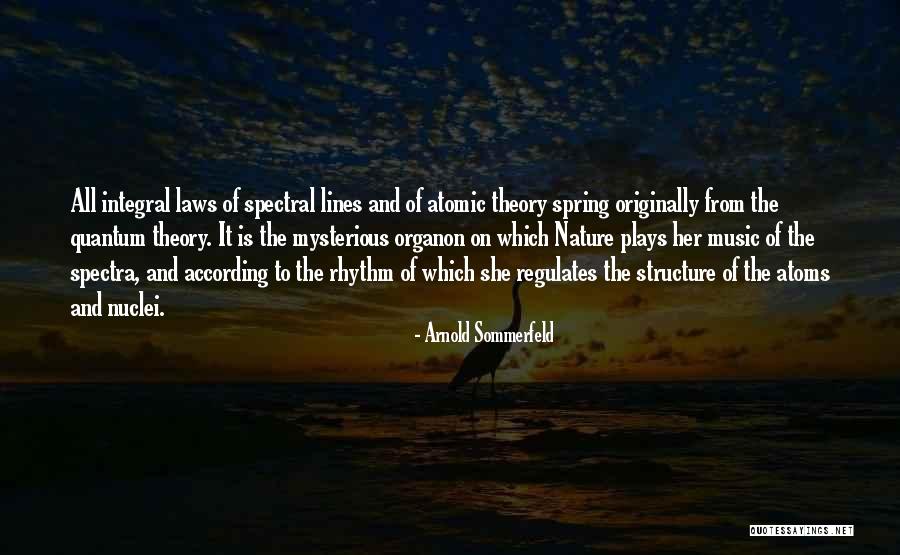
All integral laws of spectral lines and of atomic theory spring originally from the quantum theory. It is the mysterious organon on which Nature plays her music of the spectra, and according to the rhythm of which she regulates the structure of the atoms and nuclei. — Arnold Sommerfeld





